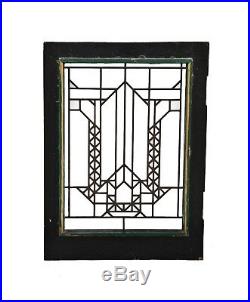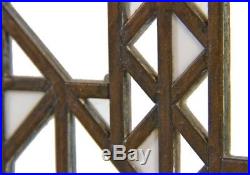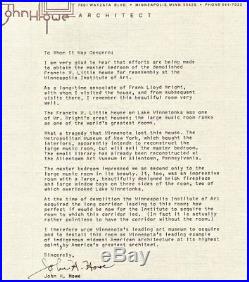Original and remarkably intact early 20th century frank lloyd wright-designed art glass window removed from the c. Little residence shortly before the dismantlement and subsequent demolition of the house in the early 1970′s. The largely colorless prairie school style window features a distinctively abstract and strongly geometric composition consisting primarily of clear glass accentuated with small white opalescent and frosted panes of triangles and squares. The nicely patinated copper-coated zinc caming remains structurally sound and overall great condition, considering age. The polychromed painted pine wood sash frame is largely intact with surface wear evident. The frank lloyd wright-designed window was fabricated by the temple art glass company, chicago, il. Around 1900 francis and mary little of peoria, il commissioned frank lloyd wright to design what was to be the first of two houses he designed for them. The littles were active founding members of the art institute of chicago, and it may have been there, where wright frequently lectured, that they and wright first came into contact. Little, a lawyer and owner of a utilities company, provided wright with financial assistance on more than one occasion. Along with two other clients, mr. The publication subsequently brought wright international attention. In the acknowledgments wright credited mr. Little as one to whom he owed a great deal for support and faith in his work. Around 1908 the littles commissioned wright to design a summer residence for them on lake minnetonka, with initial plans drawn that same year. Although several letters from mr. Little to wright indicate his frustration with the delay, the littles had a close relationship with wright and were willing to wait for him, rather than choosing another architect. During this time the littles spent their summers on the lake shore property in a small cottage that mr. Little had designed in the style of wright’s work. The home that wright designed for the littles was one of his last great prairie school-style residences. The characteristic long, low, hipped-roof building “hugged” two gentle hills that rose above the lake. The house plan consisted of two offset rectangles joined at the corner which formed a single 250-foot axis parallel to the lake shore. One rectangular section played a more private role, including the bedrooms and library above and the dining room, kitchen, and additional bedrooms below which was set into the lower hill. The other rectangular section included more public spaces, such as the large living/music room, billiard room, and screened pavilion and was set atop the higher hill. Wright designed nearly 300 windows for the house, which spanning the entire elevations, allowed the littles full advantage of the scenic view. Little died in 1923 and mrs. Little subsequently moved into her husband’s cottage and gave the summer home to eleanor and her husband raymond stevenson. Little, eleanor and their four daughters also spent part of the year at a residence in minneapolis and the other at the summer home on the lake. However, by the late 1960s the stevensons had grown weary of the challenges of living in a wright-designed house. Not wanting to move or tear down their house, and yet wanting a smaller house, put the stevensons in a difficult position because of city zoning ordinances which would not allow two houses on the same lot. Under the direction of metropolitan curator morrison heckscher, portions of the interior were carefully dismantled piece by piece for future installation in the metropolitan and to sell to other institutions. The item “SINGLE REMARKABLE C. 1913 ORIGINAL, INTACT FRANK LLOYD WRIGHT-DESIGNED LEADED AR” is in sale since Wednesday, October 31, 2018. This item is in the category “Antiques\Architectural & Garden\Stained Glass Windows”. The seller is “urbanremains” and is located in Chicago, Illinois. This item can be shipped worldwide.
Posts tagged remarkable



